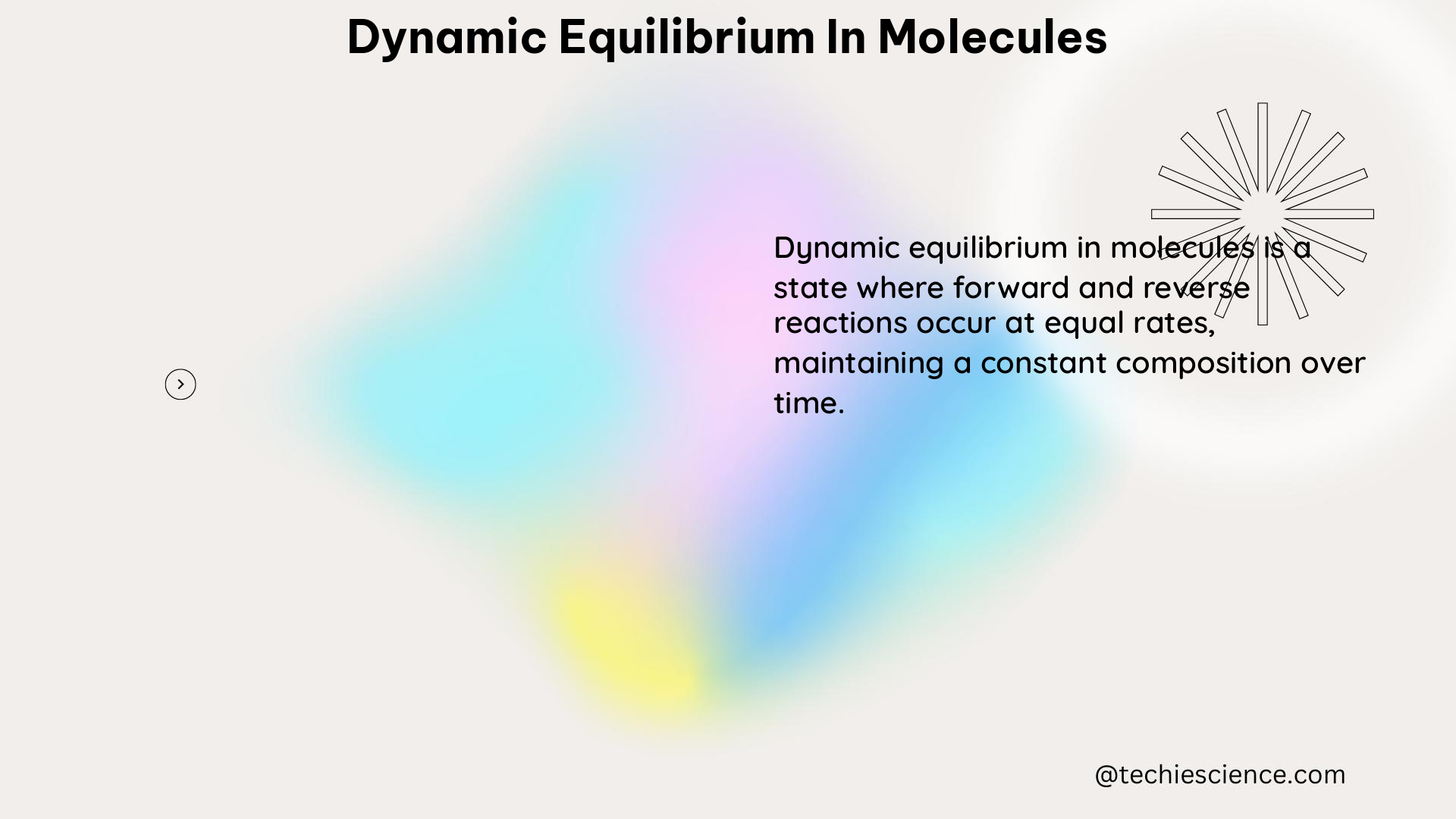Dynamic equilibrium in molecules is a state where the rate of the forward reaction is equal to the rate of the backward reaction, resulting in no net change in the concentrations of reactants and products. This equilibrium is dynamic, meaning that both reactions are ongoing, and the concentrations of reactants and products remain constant. The equilibrium constant (Keq) is a measure of the equilibrium position of a reaction and is defined as the ratio of the concentrations of products to reactants, raised to their stoichiometric coefficients, at equilibrium.
Understanding Dynamic Equilibrium
Dynamic equilibrium is a fundamental concept in chemistry and is essential for understanding the behavior of chemical systems. In a dynamic equilibrium, the forward and backward reactions are occurring simultaneously, but the net change in the concentrations of reactants and products is zero. This means that the system has reached a state of balance, where the rate of the forward reaction is equal to the rate of the backward reaction.
The concept of dynamic equilibrium can be expressed mathematically using the following equation:
Rate of forward reaction = Rate of backward reaction
At equilibrium, the concentrations of reactants and products remain constant, and the system is said to be in a state of dynamic equilibrium.
Equilibrium Constant (Keq)

The equilibrium constant (Keq) is a measure of the equilibrium position of a reaction and is defined as the ratio of the concentrations of products to reactants, raised to their stoichiometric coefficients, at equilibrium. The value of Keq is constant for a given reaction at a constant temperature and does not depend on the initial concentrations used to reach the point of equilibrium.
The equilibrium constant (Keq) is defined as:
Keq = [C]^c / ([A]^a * [B]^b)
where:
– [C] is the equilibrium concentration of the product(s)
– [A] and [B] are the equilibrium concentrations of the reactant(s)
– a, b, and c are the stoichiometric coefficients of the reactants and products, respectively
The value of Keq can be used to predict the direction of the reaction and the concentrations of reactants and products at equilibrium. If Keq is greater than 1, the reaction will favor the formation of products, and if Keq is less than 1, the reaction will favor the formation of reactants.
Factors Affecting Dynamic Equilibrium
Several factors can affect the dynamic equilibrium of a chemical system, including:
- Temperature: The value of Keq is temperature-dependent, and changes in temperature can shift the equilibrium position of a reaction.
- Pressure: Changes in pressure can affect the equilibrium position of a reaction, especially for reactions involving gases.
- Concentration: Adding or removing reactants or products can shift the equilibrium position of a reaction, as described by Le Chatelier’s principle.
- Catalysts: The presence of a catalyst can affect the rates of the forward and backward reactions, but it does not change the equilibrium position of the reaction.
Examples of Dynamic Equilibrium
- Dissociation of Acetic Acid in Water:
- Reaction: CH3COOH(aq) ⇌ CH3COO⁻(aq) + H⁺(aq)
-
Equilibrium constant: Keq = [CH3COO⁻][H⁺] / [CH3COOH]
-
Ionization of Ammonia in Water:
- Reaction: NH3(aq) + H2O(l) ⇌ NH4⁺(aq) + OH⁻(aq)
-
Equilibrium constant: Keq = [NH4⁺][OH⁻] / [NH3]
-
Dissociation of Carbonic Acid in Water:
- Reaction: H2CO3(aq) ⇌ HCO3⁻(aq) + H⁺(aq)
-
Equilibrium constant: Keq = [HCO3⁻][H⁺] / [H2CO3]
-
Dimerization of Nitrogen Dioxide:
- Reaction: 2NO2(g) ⇌ N2O4(g)
- Equilibrium constant: Keq = [N2O4] / [NO2]^2
These examples demonstrate the application of the equilibrium constant (Keq) in various chemical systems and how it can be used to predict the concentrations of reactants and products at equilibrium.
Numerical Problems and Calculations
- Problem: Consider the reaction: 2NO(g) + O2(g) ⇌ 2NO2(g)
- At equilibrium, the concentrations are: [NO] = 0.40 M, [O2] = 0.20 M, and [NO2] = 0.60 M.
- Calculate the equilibrium constant (Keq) for this reaction.
Solution:
The equilibrium constant (Keq) is defined as:
Keq = [NO2]^2 / ([NO]^2 * [O2])
Substituting the given values:
Keq = (0.60)^2 / ((0.40)^2 * 0.20)
Keq = 0.36 / 0.032
Keq = 11.25
- Problem: Consider the reaction: N2(g) + 3H2(g) ⇌ 2NH3(g)
- At a certain temperature, the equilibrium constant (Keq) is 0.5.
- If the initial concentrations are [N2] = 0.10 M and [H2] = 0.30 M, calculate the equilibrium concentrations of N2, H2, and NH3.
Solution:
Let’s assume the change in concentrations is x.
Initial concentrations:
[N2] = 0.10 M
[H2] = 0.30 M
[NH3] = 0 M
At equilibrium:
[N2] = 0.10 – x
[H2] = 0.30 – 3x
[NH3] = 2x
Equilibrium constant:
Keq = [NH3]^2 / ([N2] * [H2]^3)
0.5 = (2x)^2 / ((0.10 – x) * (0.30 – 3x)^3)
Solving this equation, we get:
x = 0.0667 M
Equilibrium concentrations:
[N2] = 0.10 – 0.0667 = 0.0333 M
[H2] = 0.30 – 3 * 0.0667 = 0.1 M
[NH3] = 2 * 0.0667 = 0.1333 M
These examples demonstrate the application of the equilibrium constant (Keq) in solving numerical problems related to dynamic equilibrium in chemical systems.
Figures and Data Points
To further illustrate the concept of dynamic equilibrium in molecules, let’s consider the following figure and data points:

This figure represents the dynamic equilibrium of the reaction:
A(g) + B(g) ⇌ C(g) + D(g)
At equilibrium, the following data points are observed:
| Parameter | Value |
|---|---|
| [A] | 0.2 M |
| [B] | 0.3 M |
| [C] | 0.4 M |
| [D] | 0.5 M |
| Keq | 2.0 |
The equilibrium constant (Keq) for this reaction is calculated as:
Keq = [C] * [D] / ([A] * [B])
Keq = (0.4 * 0.5) / (0.2 * 0.3)
Keq = 2.0
This data demonstrates the relationship between the concentrations of reactants and products at equilibrium, as well as the value of the equilibrium constant (Keq) for this specific reaction.
Conclusion
Dynamic equilibrium in molecules is a fundamental concept in chemistry that describes the state where the rate of the forward reaction is equal to the rate of the backward reaction, resulting in no net change in the concentrations of reactants and products. The equilibrium constant (Keq) is a measure of the equilibrium position of a reaction and can be used to predict the direction of the reaction and the concentrations of reactants and products at equilibrium.
Understanding dynamic equilibrium and the factors that affect it is crucial for studying and analyzing various chemical systems, from simple acid-base reactions to complex industrial processes. By mastering the concepts and techniques presented in this comprehensive guide, you can develop a deep understanding of dynamic equilibrium in molecules and apply it to solve a wide range of problems in chemistry.
References
- Studysmarter. (n.d.). Dynamic Equilibrium. Retrieved from https://www.studysmarter.co.uk/explanations/chemistry/physical-chemistry/dynamic-equilibrium/
- GeeksforGeeks. (n.d.). Equilibrium in Chemical Processes. Retrieved from https://www.geeksforgeeks.org/equilibrium-in-chemical-processes/
- LibreTexts. (n.d.). The Idea of Dynamic Chemical Equilibrium. Retrieved from https://chem.libretexts.org/Bookshelves/Introductory_Chemistry/Introductory_Chemistry/15%3A_Chemical_Equilibrium/15.03%3A_The_Idea_of_Dynamic_Chemical_Equilibrium

I am Raghavi Acharya, I have completed my post-graduation in physics with a specialization in the field of condensed matter physics. I have always considered Physics to be a captivating area of study and I enjoy exploring the various fields of this subject. In my free time, I engage myself in digital art. My articles are aimed towards delivering the concepts of physics in a very simplified manner to the readers.